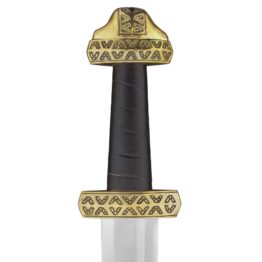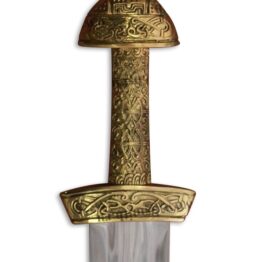Caroling type W with bronze set
€230.00
Caroling type W. Norway, Russia and the Baltics X century
The blade is made of spring tempered steel.
Blade is hardened (Hardness 50 HRC).
Blade length: 79-80 cm.
Total length of the sword: 95-96 cm.
Guard width: 19 cm.
Blade width at guard: 5 cm.
Blade thickness at guard: 5 mm.
Sword weight: 1400 g.
100% Battle ready.There are no weaknesses in the design.The difference from edged weapons
– the lack of sharpening the blade.Blade blunted (edge thickness of 2 mm).
J. Petersen studied a total of 8 swords of type W – he did not have more at his disposal. It turned out that they all originate from the West of Norway, or its border areas. Another W-type sword – or rather, the pommel, remaining from it, the researcher discovered in the Swedish Historical Museum. On this basis, he concluded that Norway of the X century is the birthplace of this type of sword. Further archaeological research found the types W on the territory of Russia and the Baltic states. In all, Petersen examined 8 W type swords, but only three of them have blades. All three are double-edged, highly corroded, so a dense examination of the blades was impossible. As one of the type-forming signs, the researcher named cast bronze hilt details — the pummel and crossgard. Pummel is one-piece, but it externally imitates a two-piece, and the top of the pummel divided into three parts. The effect is achieved by parallel decorative grooves






















Reviews
There are no reviews yet.